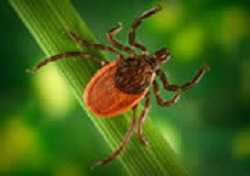LYME DISEASE
Overview

Photos courtesy of CDC Public Health Image Library
Lyme disease is the most commonly reported tick-borne disease in the United States. In 2010, more than 22,500 confirmed and 7,500 probable cases of Lyme disease were reported to the Centers for Disease Control and Prevention (CDC). Lyme disease is passed to humans by the bite of black-legged ticks (also known as deer ticks in the eastern United States) and western black-legged ticks infected with the bacterium Borrelia burgdorferi. The Lyme disease bacterium normally lives in mice, squirrels, and other small mammals.
Outdoor workers are at risk of Lyme disease if they work at sites with infected ticks. In 2010, the highest number of confirmed Lyme disease cases were reported from New Jersey, Pennsylvania, Wisconsin, New York, Massachusetts, Connecticut, Minnesota, Maryland, Virginia, New Hampshire, Delaware, and Maine. U.S. workers in the northeastern and north-central States are at highest risk of exposure to infected ticks. Ticks may also transmit other tick-borne diseases to workers in these and other regions of the country. Worksites with woods, bushes, high grass, or leaf litter are likely to have more ticks. Outdoor workers should be extra careful to protect themselves in the late spring and summer when young ticks are most active.
Feature

Protecting Yourself from Ticks and Mosquitoes: Print or order this free card for easy access to important safety information.
- Page last reviewed: September 21, 2011
- Page last updated: August 3, 2017
- Content source:
- National Institute for Occupational Safety and Health Education and Information Division


 ShareCompartir
ShareCompartir